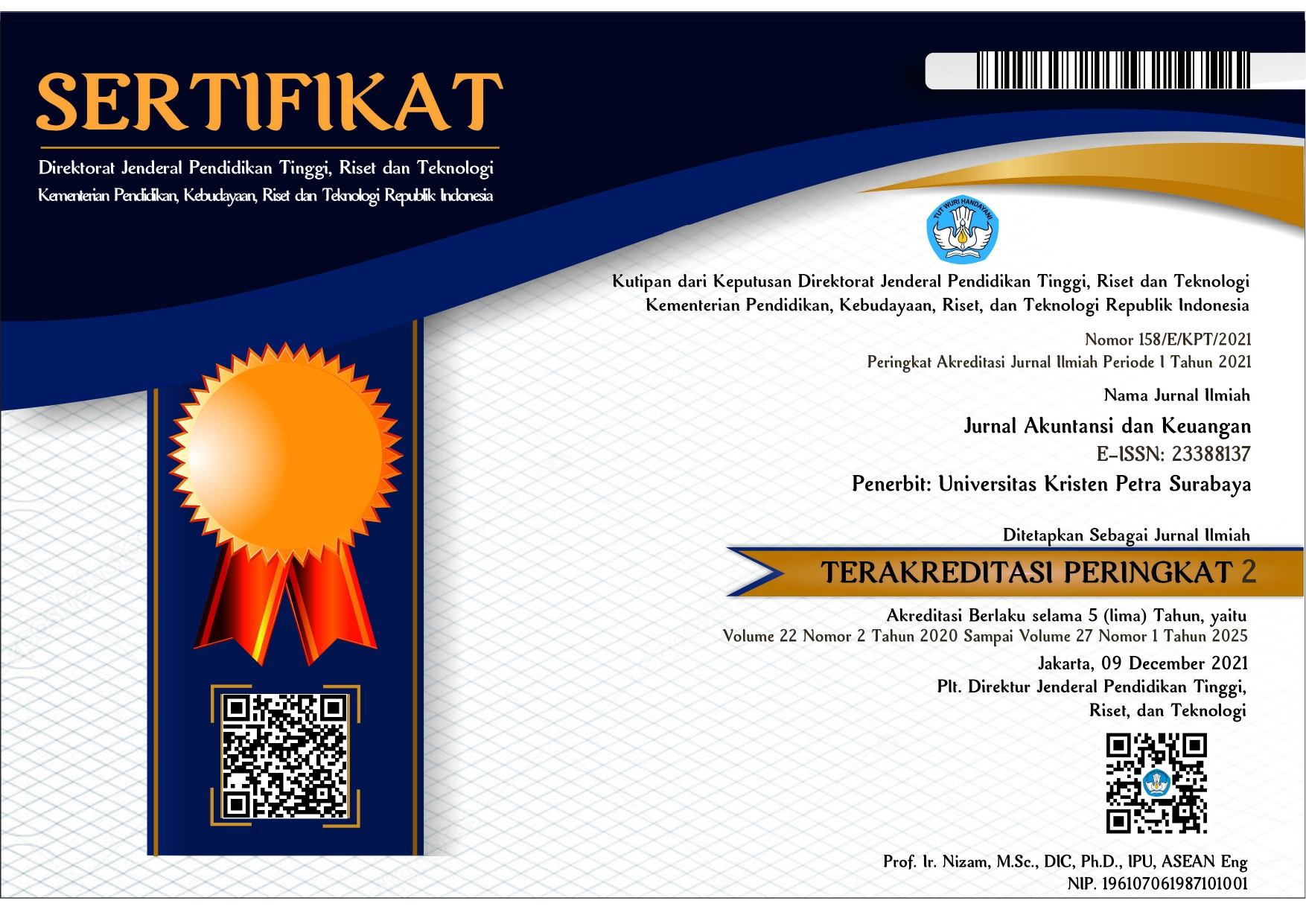Earnings Management of Firms Reporting Long Term Debt: An Alternative Method
DOI:
https://doi.org/10.9744/jak.16.2.113-120Keywords:
Foreign exchange loss, earnings management, positive accounting theoryAbstract
This study aims to apply an alternative detection model to prove that the earnings management will be occured when a company has long-term debts as well as the pressure of operating income. Generally, the literature study of earnings management indicates that the detection of earnings management can be grouped into two objectives, 1] to find variables for detecting earnings management (accruals, real activity and classification shifting) and 2] to use some advanced statistical or mathematical models to detect earnings management. This study applies a quantitative approach using secondary data of financial statements. The study was conducted on 50 companies with the largest market capitalization, 50 of the most active companies based on trading volume, 50 of the most active companies based on the value of trade and 50 of the most active companies by frequency trading. All of them are 200 public company (listed in the Indonesia Stock Exchange-ID) based on IDX statistical report 2013. The results of this study are expected to provide a new method to detect earnings management and its application in the context of positive accounting theory (PAT). The results of the study proves that the model is able to detect earnings management by utilizing foreign exchange transaction losses and use these models to support PAT (particularly on debt covenant hypothesis). These results contribute that earnings management can be done by using the foreign exchange gain / loss. However, the limitation of this study is the model has not been able to capture the phenomenon of earnings management if a company does not report any long-term debt nor foreign exchange gain/ loss.References
Becker, C. L., Mark, L., Defond, Jiambalvo, J., and Subramanyam, K. R. (1998). The Effect of Audit Quality on Earnings Management. Contemporary Accounting Reserch. Spring, 15(1), pp. 1-24.
Bharath, S. T., Jayanthi, S., and Shyam, V. (2008). Accounting Quality and Debt Contracting. The Accounting Review, 82(1), pp, 1-28.
Chen, T. (2010), Analysis on Accrual-Based Models in Detecting Earnings Management. Lingnan Journal of Banking, Finance and Economics, 2, 2010/2011
Dechow, P. M., Richard, G. S., and Amy, P. S. (1995). Detecting Earnings Management, The Accounting Review, 70(2), pp. 193-225.
Dechow, P. M. & Ilia, D. D. (2002). The Quality of Accrual dan Earnings: The Role of Accrual Estimation Errors. The Accounting Review: Supplement 2002. 77(s-1), pp. 35-59.
Defond, M. L., & Jiambalvo, J. (1994), Debt Covenant Violation and Manipulation of Accruals. Journal of Accounting and Economics, 17, pp. 145-176.
Eldenburg, L. G., Katherine, A. G., Kevin, W. H., and Soderstrom, N. (2011). Earnings Management Using Real Activities: Evidence from Nonprofit Hospitals. The Accounting Review, 86(5), pp. 1605-1630.
Ezazi, M. E., Fatemeh, S. G., and Seyed, F. G. (2013). Predicting Earnings Management using RBF. ICA and SVM in Firm Listed in Tehran Security Exchange. Asian Journal Of Management Research, 4(1), pp. 208-220.
Hoglund, H. (2010). Detecting Earnings Management Using Neural Networks, Hanken School of Economics. Department of Accounting and Commercial Law. Vaasa, Finland.
Islam, Md. A., Ruhani, A., and Zamri, A. (2011). Is Modified Jones Model Effective in Detecting Earnings Management? Evidence from A Developing Economy. International Journal of Economics and Finance, 3(2), pp. 116-125.
Jaggi, B. & Picheng, L. (2002), Earnings Management Response to Debt Covenant Violations and Debt Restructuring, Journal of Accounting, Auditing & Finance, 17: 295.
Jones, J. J. (1991). Earnings Management during Import Relief Investigations. Journal of Accounting Research, 29, pp. 193-228
Kirkos, E., Charalambos, S., and Yannis, M. (2007). Data Mining Tchniques for The Detection of Fraudulent Financial Statements. Expert System with Application, 32, pp. 995-1003
Mc Vay, S. E. (2006). Earnings Management Using Classification Shifting: An Examination of Core Earnings and Special Items, The Accounting Review, 81(3), pp. 501-531.
Siregar, N. P. dan Utama, S. (2006). Pengaruh Struktur Kepemilikan, Ukuran Perusahaan dan Praktik Corporate Governance terhadap Pengelolaan Laba (Earnings Management). The Indonesian Journal of Accounting Research, 9(3).
Peasnell, K., Peter, P., and Steven, Y. (2006). Do Outside Directors Limit Earnings Management?. Corporate Finance Review, 10(5).
Roychowdhury, S. (2006). Earnings Management through Real Activities Manipulation, Journal of Accounting and Economics. 42, pp. 335–370.
Scott, William R. (2012). Financial Accounting Theory, 6th edition, Pearson Prentice Hall. USA.
Stubben, S. R. (2010). Discretionary Revenues as a Measure of Earnings Management. The Accounting Review, 85(2), pp. 695-717.
Sweeney, A. P. (1994). Debt-Covenant Violations and Managers’ Accounting Responses. Journal of Accounting and Economics 17, pp. 281-308.
Watts, R. L. and Jerold, L. Z. (1990). Positive Accounting Theory: A Ten Year Perspective, The Accounting Review, 65(1), pp. 131-156.
www.bi.go.id/id/moneter/informasi-kurs/transaksi-bi/default.aspx. accessed August 2014.
www.idx.co.id, accessed September 2014. March 2015.
Downloads
Published
How to Cite
Issue
Section
License
Authors who publish with this journal agree to the following terms:
- Authors retain the copyright and publishing right, and grant the journal right of first publication with the work simultaneously licensed under a Creative Commons Attribution License that allows others to share the work with an acknowledgement of the work's authorship and initial publication in this journal.
- Authors are able to enter into separate, additional contractual arrangements for the non-exclusive distribution of the journal's published version of the work (e.g., post it to an institutional repository or publish it in a book), with an acknowledgement of its initial publication in this journal.
- Authors are permitted and encouraged to post their work online (e.g., in institutional repositories or on their website) followingthe publication of the article, as it can lead to productive exchanges, as well as earlier and greater citation of published work (See The Effect of Open Access).<a href="http://creativecommons.org/lice














